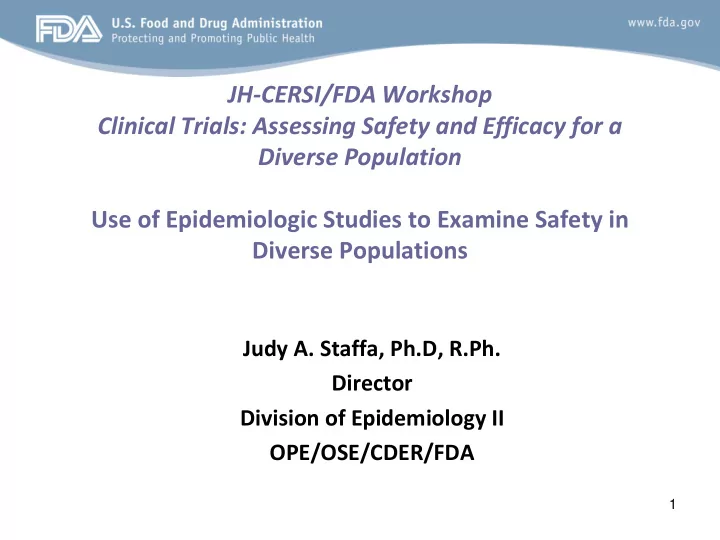

JH-CERSI/FDA Workshop Clinical Trials: Assessing Safety and Efficacy for a Diverse Population Use of Epidemiologic Studies to Examine Safety in Diverse Populations Judy A. Staffa, Ph.D, R.Ph. Director Division of Epidemiology II OPE/OSE/CDER/FDA 1
Use of epidemiologic studies to quantify safety issues and identify risk factors • Types of studies/data available • Challenges in identifying certain subgroups in large populations – Age – Sex (Pregnancy) – Race/Ethnicity – Comorbidities and other Determinants of Health – Genetically defined subgroups 2
Sources of Drug Safety Information Spontaneous Adverse Event Reports Product Quality Clinical Trials Reports Animal Drug Safety Observa- Toxicology Information tional Studies Studies Pharmaco- genomics Registries Studies Clinical Pharmaco- logy Studies 3
Types of postmarketing observational studies • Prospectively collected data – more flexible/opportunities for custom data collection – Registries – Cohorts – Case/control surveillance • Retrospectively collected data – secondary use – less flexible, but opportunities for linkages/enhancements – Electronic healthcare data • Administrative claims • Electronic health records 4
Electronic healthcare data • Electronic medical records (EMR) • Administrative claims – Collected for clinical care – Collected for reimbursement – Diagnoses coded in more – Diagnoses are coded, usually granular ways ICD-9 – Often free text – Inpt codes more reliable than outpt codes for diagnoses – Drugs are those prescribed, not disp. – Pharmacy claims captured by Nat’l Drug Code (NDC) – Has clinical detail, but can be tough to extract – Little clinical detail; maybe access to charts 5
Typical examples • Electronic medical • Administrative claims records (EMR) – CMS (Medicare) – GE Centricity – Health Core – CPRD (UK) – IMS Health Life Link – THIN (UK) – Optimum Insight (UHC, Ingenix) • Hybrids/Integrated care – Sentinel – Kaiser Permanente – Medicaid – Veterans Administration – Dept of Defense 6
Subpopulations of interests – some high level thoughts 7
Subpopulations of interest: AGE • Pediatric – Medicaid – lots of sick/indigent children – Commercially insured populations – healthier kids – Challenges: • Sample size • Lack of clinical detail on outcomes of interest – e.g, growth, neurodevelopment, metabolic function • Women of childbearing age – Fairly straightforward in most data sources – Harder to identify “women of childbearing potential” • Elderly (65+ years) – harder than you might think! 8
Studying drug safety issues in the elderly • Medicare coverage begins in the U.S. at 65 years of age – CMS is primary insurer • Part A (Hospitalization) • Part B (Outpatient) • Part C (Capitated payments – no itemized utilization available) • Part D (prescription drug coverage) – Many administrative claims data only include “supplemental coverage”, so only include claims NOT reimbursed by Medicare • Affects ability to ascertain drug-related safety outcomes • Linkage to Medicare claims solves problem – Some administrative claims systems administer Medicare Part C • Can ascertain complete care not visible to CMS • Challenge – know what data you are working with! 9
Subpopulations of interest: SEX • Sex – Can tailor selection of study population to target male or female populations • Older males – Veterans Administration • Female Sex - Pregnancy – In claims data, easy to identify DELIVERY – hard to identify PREGNANCY – Mother-baby linkages have been developed – link to birth certificates • Birth certificates are rich source of additional information – Algorithms have been developed – common data models developed • MEPREP, DoD, CPRD, Medicaid MAX 10
Subpopulations of interest: RACE/ETHNICITY • Notoriously difficult to study – Inaccuracy – how the information is collected – Incompleteness – a problem in most databases • CMS/Medicare – Patient-reported – validity believed to be high, except for “Hispanic” • CPRD – Recent study documented improvements in validity and completeness since 2006 • Sentinel – Varies across data partners; not complete for entire data system • Challenge – Race/Ethnicity are difficult subgroups to study in currently available postmarketing data resources 11
Subpopulations of interest: COMORBIDITIES and other determinants of health • Medical conditions in administrative claims data are only identifiable by ICD-9 or ICD-10 codes – Outpatient codes not very reliable • Well known strategies to maximize payments • “Rule - out” diagnoses are common – Inpatient codes more scrutinized • Still may need validation • Comorbid conditions may be chronic – no hospitalization – Success is variable – depending on condition • E.g., Cardiovascular risks in diabetic patients taking high doses of olmesartan • Other determinants of health (BMI, Smoking) most often not available 12
Subpopulations of interest: Genetically defined • Genetic data are becoming more available than in the past – Subpopulations with these data available are still relatively small • Kaiser Permanente • Marshfield Clinic • Vanderbilt University – Linkages to drug exposure and medical outcome data not yet common • Ethical/privacy issues and concerns – When genetic subgroup is more prevalent in specific group defined by race/ethnicity – harder to get meaningful sample sizes • E.g. Antiepileptic drugs and risk for Stevens-Johnson Syndrome (SJS) • Bottom line – prospectively collected data may be only option at the current time 13
How well can we study subgroups using observational postmarketing studies? • Commonly used data sources for retrospective postmarketing observational safety studies have significant limitations for studying many subpopulations – Some characteristics are easier/more difficult than others to define – Attaining appropriate sample size is a challenge for most – Important to thoroughly understand data source with regard to these characteristics • How are these variables collected? • How complete are these variables and related information on the subpopulation in the data source? • Frequent reason for requesting prospective data collection – Need to provide detailed rationale for appropriate capture of data 14
Recommend
More recommend